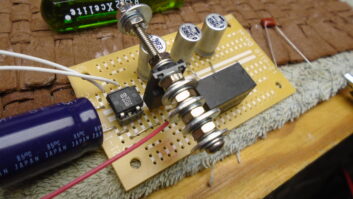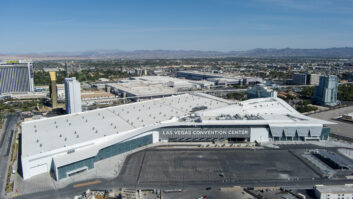
This Hunter Concert Breeze Fan & Sound System with integrated Soundolier wireless technology comes as an indoor or indoor/outdoor fan. The author owns WHDX(FM) and WHDZ(FM), Buxton, N.C., on Hatteras Island. He is senior director, technology & standards at the Consumer Electronics Association, and his commentaries are a recurring feature of Radio World’s opinion section. Views are his own and do not necessarily represent those of CEA or its member companies.
There were a number of things at the 2009 International CES that should be of interest to radio broadcasters. Two big themes related to radio were further developments in HD Radio and the latest in mobile television.
On the HD Radio front, the iBiquity booth was filled with numerous products, including a small wearable receiver with a built-in MicroSD slot that can be used for playing recorded music. It’s called the KRI Armband Portable HD Radio Player. And speaking of portable HD Radio, SiPort was displaying its HD Radio chipset, which was designed with particular attention paid to power consumption so it would be useful in portable and handheld devices.

The cable that connects these headphones to an audio device has a built-in limiter that limits the audio level to 85 dB SPL. SiPort was also showing off a system that allows consumers to record HD Radio programs. I found this particularly interesting because I firmly believe that radio needs to have storage capability in its receivers in order to compete effectively.
A receiver that could gather and organize content even when the consumer isn’t listening would provide consumers with a much better selection of programming. Radio needs to offer consumers a better selection to compete more effectively with MP3 players and satellite radio.
Several companies were displaying mobile DTV receivers, and the Open Mobile Video Coalition announced that 63 TV stations in 22 markets have plans to deploy this technology. Mobile DTV is made possible by adding some additional digital coding to standard DTV broadcasts, enabling moving receivers to decode the DTV signal.
Mobile DTV
This is critically important to radio because it won’t be long before we start seeing TV receivers in cars, where radio has traditionally had an advantage. People may not be able to watch TV while they’re driving, but they can still listen.
It’s easy for me to believe that many of the people who watch “Today” or “Good Morning America” and similar TV shows will remain tuned in to those programs during their morning commutes once they have that capability in their cars. This direct assault on radio morning shows would have a dramatic impact on the radio industry.
Some other things of interest to radio broadcasters at CES included Safe Volume headphones and earbuds from iHearSafe. The cable that connects these headphones to an audio device has a built-in limiter that limits the audio level to 85 dB SPL.
Audio at levels above 85 dB is reduced to 85 dB, while other audio passes through unchanged. This is a terrific invention and of great use in an industry that relies so much on headphone audio. It’s also great for your kids. The limiter is built into the headphone cable and can’t be removed without ruining the headphones.

The Rock-Ola Music Center is meant to be like an iPod but in a much larger package that invites other people to use it. There was also the Dice Electronics Digital AM/FM receiver, designed with blind people in mind. When you change stations there’s an audible announcement from the receiver telling you what frequency you’ve tuned to, or what control setting you just changed. While it was designed for the blind and visually-impaired, it could also help you tune your radio and keep your eyes on the road at the same time.
I also liked the duo wireless speaker lamp from Soundolier. It’s a floor lamp with a long stem that looks like a typical halogen lamp. What’s cool about it is that the top of it is not only a light, but a speaker too.
It has a receiver for a wireless system in it and you connect the associated transmitter to your favorite audio equipment. The result is a hidden speaker in your room that doesn’t require any separate wires.
This device won an Innovations award at the 2007 CES and has been such a hit that Hunter has now come out with an accompanying ceiling fan that has a speaker disguised in the light assembly. These two products let you disperse sound throughout your home without running any wires, or seeing any speakers. Pretty cool.
Finally, there was the Rock-Ola Music Center. Imagine this, an Apple iPod-like touch screen device that’s as big as your flat-screen TV, comes loaded with something like 9,000 songs, and works like a modern jukebox. You install it on your wall, or on a piece of furniture, and you and your party guests can walk up to it and slide songs into the playlist, create new playlists, and so on.
It also includes album art, cross-fading capability and a five-band graphic equalizer. It’s meant to be like an iPod, but in a much larger package that invites other people to use it. In contrast, many people wouldn’t touch another person’s portable MP3 player because it’s considered too personal.
Those are some of the cool things I saw at the 2009 CES. Hope to see you there next year.












